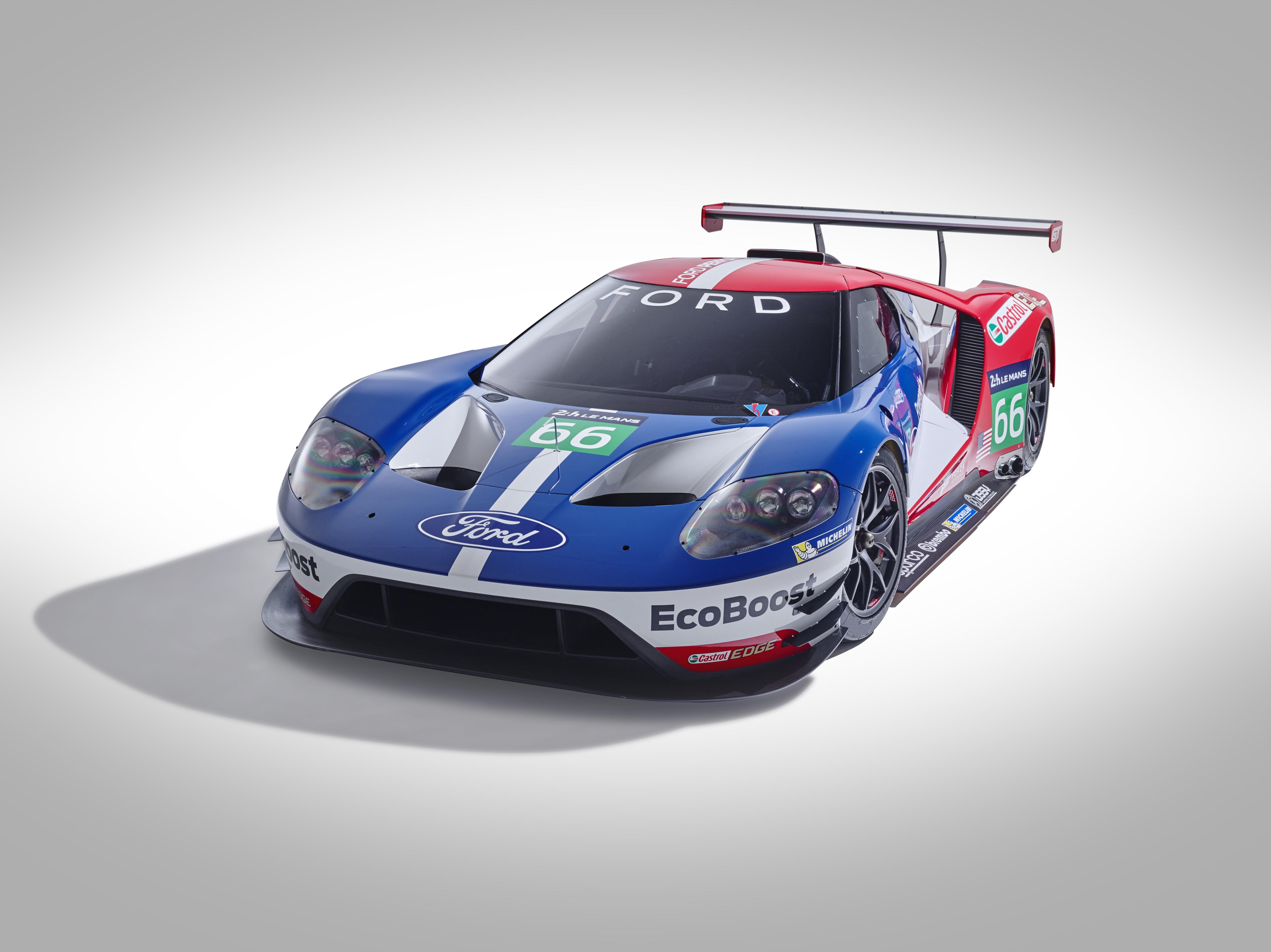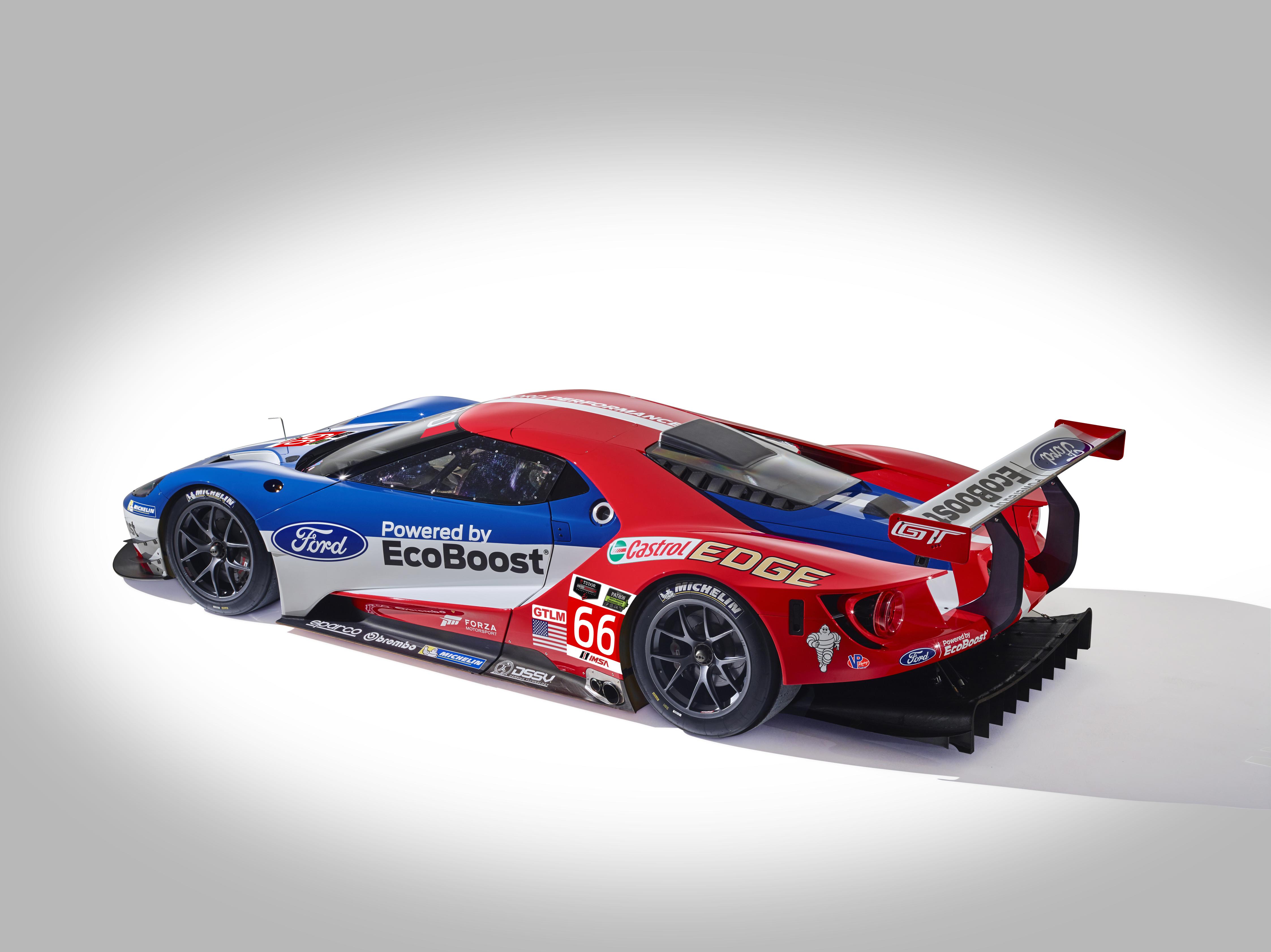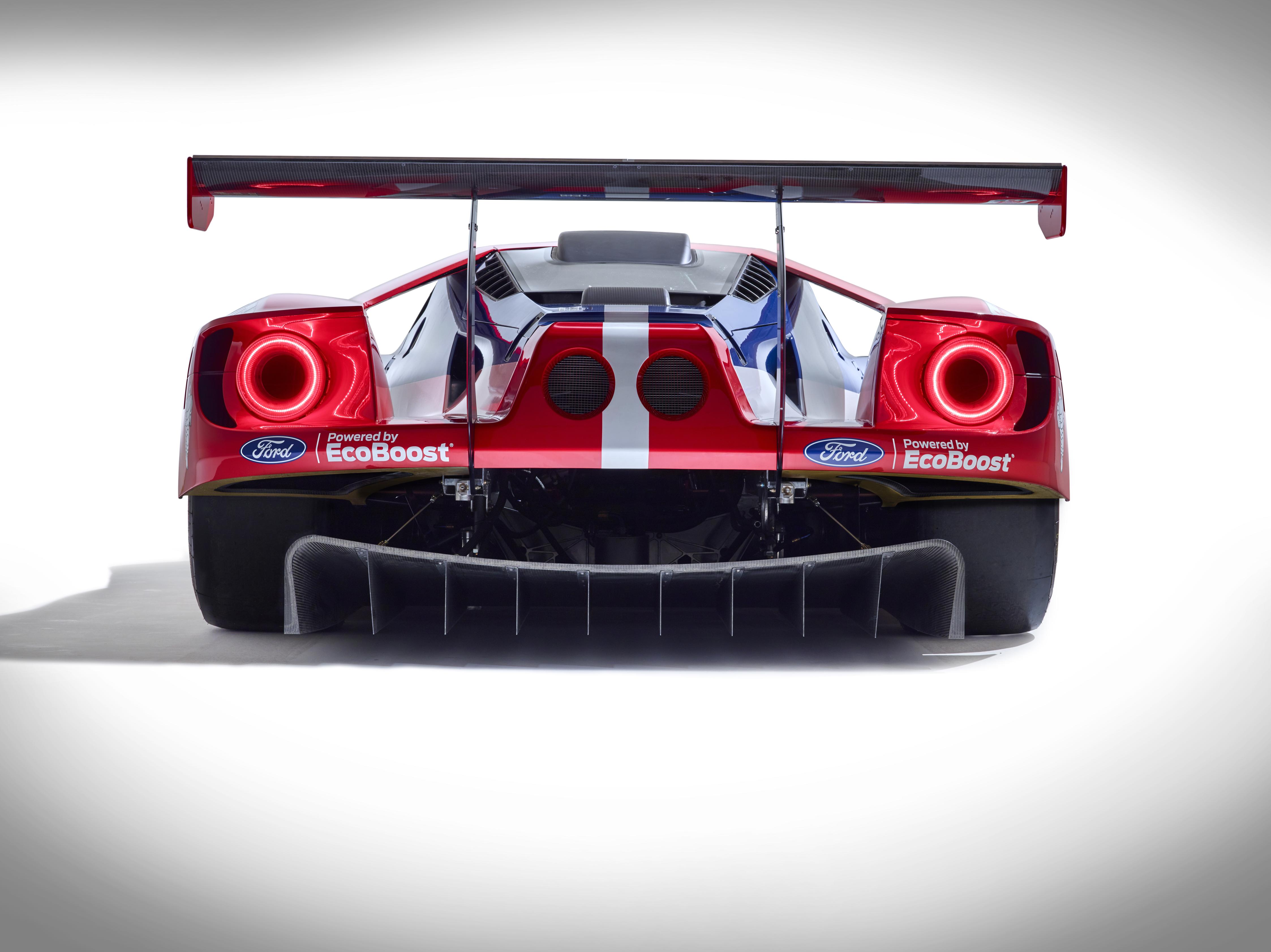- Ford returns to Le Mans in 2016 with the all-new Ford GT supercar to compete in LM GTE Pro class, commemorating the 50th anniversary of Ford’s 1966 overall victory
- All-new Ford factory program to compete in both the FIA World Endurance Championship and TUDOR United SportsCar Championship with a two-team, four-car effort – operated by Chip Ganassi Racing with Felix Sabates
- Ford GT is company’s showcase for aerodynamics and lightweight carbon fiber construction, along with new twin-turbocharged Ford EcoBoost® V6 – most powerful EcoBoost production engine ever
Ford announced today it is returning to one of the most prestigious automobile races in the world with its new Ford GT race car, based on the all-new ultra-high-performance supercar that goes on sale next year.
The Ford GT race car will compete in the 24 Hours of Le Mans – referred to by many as the Grand Prix of Endurance and Efficiency – starting next year. Revealed today at the famous circuit in Le Mans, France, Ford GT will compete in the Le Mans GT Endurance class for professional teams and drivers (LM GTE Pro).
The new race car – a further proof point of Ford innovation – is based on the all-new Ford GT supercar unveiled in January. Both the production car and race car will arrive in 2016 to mark the 50th anniversary of Ford GT race cars placing 1-2-3 at the 1966 24 Hours of Le Mans. Ford went on to repeat its victory at Le Mans in 1967, 1968 and 1969.
“When the GT40 competed at Le Mans in the 1960s, Henry Ford II sought to prove Ford could beat endurance racing’s most legendary manufacturers,” said Bill Ford, executive chairman, Ford Motor Company. “We are still extremely proud of having won this iconic race four times in a row, and that same spirit that drove the innovation behind the first Ford GT still drives us today.”
The new Ford GT race car will run the full 2016 schedules of the FIA World Endurance Championship and TUDOR United SportsCar Championship, making its competition debut in January 2016 in the Rolex 24 At Daytona, Florida. The two Ford teams will be operated by Chip Ganassi Racing with Felix Sabates (CGRFS). Both series teams intend to compete with a four-car effort at Le Mans. Drivers will be announced later.
The all-new Ford GT serves as the pinnacle product of the new Ford Performance group, a division dedicated to providing innovation through performance.
Set to deliver more than 12 new performance vehicles by 2020, Ford Performance will leverage its racing efforts and expertise to speed innovations on dedicated performance models and performance parts in order to more quickly iterate the latest technologies that can ultimately be applied to the full Ford vehicle lineup.
The performance segment is a growing business for Ford, as the company recognizes its customers’ desire for vehicles that offer excellent fuel economy, leading technology and a great driving experience. The Ford Performance lineup includes Ford GT, Focus RS, F-150 Raptor, Shelby GT350 and Shelby GT350R, Focus ST and Fiesta ST.
“Ford remains focused on three priorities globally – accelerating our One Ford plan, delivering product excellence with passion and driving innovation in every part of our business,” said Mark Fields, Ford Motor Company president and CEO. “All three came together to create the new Ford GT. We also know from our rich history in motorsports that world-class competition is a great incubator for even further product innovation.”
The Ford GT race car features a number of innovations Ford believes will not only make it competitive in LM GTE Pro, but ultimately positioned to provide benefits to each vehicle in the Ford lineup. These include state-of-the-art aerodynamics to deliver outstanding levels of downforce for improved stability with minimal drag, advanced lightweight composites featuring carbon fiber for an exceptionally rigid but light chassis, and the power and efficiency of EcoBoost technology.
“As we developed the Ford GT, from the outset, we wanted to ensure we had a car that has what it takes to return Ford to the world of GT racing,” said Raj Nair, Ford Motor Company group vice president, Global Product Development and chief technical officer. “We believe the Ford GT’s advances in aerodynamics, light-weighting and EcoBoost power will make for a compelling race car that can once again compete on a global stage.”
Joining Ford in this project are Multimatic Motorsports, Roush Yates Engines, Castrol, Michelin, Forza Motorsport, Sparco, Brembo and CGRFS. The race car has undergone extensive design and testing within Ford and Multimatic, with CGRFS providing input into the development. Roush Yates is supporting development of the 3.5-liter EcoBoost V6 – the most powerful EcoBoost production engine ever.
The 3.5-liter EcoBoost V6 engine debuted in the TUDOR United SportsCar Championship in 2014. Since then, Ford, with CGRFS, has captured significant overall wins at the 12 Hours of Sebring and Rolex 24 At Daytona. Besides great success in sports cars, Ganassi race teams achieved major victories in the Daytona 500, Brickyard 400 and Indianapolis 500.
“We’ve won races and championships, but we’ve never run Le Mans,” said team owner Chip Ganassi. “When presented the opportunity to compete with the all-new Ford GT on the world’s biggest sports car stage, and on the 50th anniversary of one of the most storied victories in racing history, how could any race team not want to be part of that? Will it be a challenge? Absolutely, but we couldn’t be with a better partner than Ford.”




GT40 ONE-TWO AT LE MANS LEGEND
A day after making the headlines with their return to Le Mans, Ford grabbed the limelight in the Le Mans Legend as well, as a pair of GT40s that competed at La Sarthe in the 1960s finished one-two.
Bernard Thuner, a veteran of three Le Mans 24 Hours races, was dominant in Claude Nahum’s GT40, Nahum having bowed out of sharing the car in the race subsequent to a hairy spin in Thursday’s qualifying. The 1994 Swiss Touring Car Champion only lost the lead temporarily during the pitstop phase, while Andrew Smith and James Cottingham ensured there were two Fords on the podium.
There could have been even more Blue Oval representation on the rostrum, but for a mechanical problem late in the race for Diogo Ferrao/Martin Stretton’s front row-starting machine.
The GT40s were a new and very welcome addition to the biannual support race, after the regulations were extended to cover iconic machinery from 1949-1968, allowing the more modern Fords to take part.
Thuner streaked away from pole in his Ford, which competed in the 24-hour race in 1968 in the hands of Mike Salmon and Eric Lidell, while Ferrao maintained a watching brief.
Further back there was drama for Smith as he spun at Indianapolis and lost a host of places. Also losing out at the start was Richard Meins’ GT40 as Sylvain Stepak’s Alpine A220 got the jump off the line.
It was a troublesome start for Barrie Williams in the Mini Marcos GT as he spun the bright yellow machine into the Indianapolis gravel. By the time he was given a helping hand out, he had dropped to the very rear of the field.
Over the next few laps, the GT40s streaked away at the front while Smith, in the ex-Scuderia Bear GT40 which was punted out of the ’66 Le Mans 24 Hours during qualifying, quickly made up for his error, surging up the order to claim second place at the second Mulsanne chicane on the penultimate lap. Smith commented: “Driving that thing down the Mulsanne Straight was just phenomenal.”
While Smith made up places, the Alpine dropped back with Stepak and Jean Luc Blanchemain eventually falling to seventh. This beautiful machine is a fascinating piece of motorsport history in more ways than one, having pioneered slick tyres when it went to Le Mans in 1968 with Michelin.
The safety car was deployed late in the race after a significant amount of oil was deposited on the track. When the pace car peeled into the pits, the cars crossed the line to take the chequered flag, ensuring that Thuner triumphed over the 61-car grid.
Ludovic Caron in a Shelby Cobra made a cheeky late lunge out of the final corner to steal second across the line, but the Stewards later relegated him back to third as safety car conditions still prevailed, giving a GT40 one-two. Caron claimed Class 4 honours for larger-engined 1960-68 cars, and third overall was still a good result after his sixth place grid slot.
There were other GT40s in the top six as well, as Meins claimed fifth and Philip Walker/Miles Griffiths’ machine took sixth, while an AC Cobra was fourth in the hands of David Hart – up from ninth at the start.
There were dominant victors in all of the other classes, with the majority of the winners maintaining the lead throughout the race.
Class 1 for over 2000cc 1949-54 cars was won by John Young in JD Classics’ bronze Jaguar C-type, while Class 2 for similarly-engined slightly newer machinery was topped by Clive Joy and Jarrah Venables’ pale blue D-type; a car with a versatile motorsport career, having been raced, hillclimbed and even rallied.
The Class 3 win for under 2000cc 1955-59 specimens went to Dion Kremer in the Lotus 17 Prototype and Class 5 (for 1960-65 under 2000cc entries) was won by Afschin Fatemi in his Porsche 904/6, one of two prototypes originally fitted with an eight-cylinder engine by Porsche for the 1964 24 Hour race.
A total of 14 cars entered had originally competed at Le Mans 24 Hour enduros, with other cars that had raced around the legendary French track in period including another GT40 from 1966, which Marc Doncieux raced to 11th place in the Legend event.
But the immense heat of the early Saturday sunshine took its toll on many of the cars, including some of the Le Mans veterans. Holly Mason-Franchitti/Charles Knill-Jones’ Alfa Romeo TZ1 from 1964 was among those to suffer and didn’t complete the first lap.
A number of the drivers were also veterans of the ‘world’s greatest motor race’ with former British Touring Car Champion Steve Soper making his first appearance at Le Mans in over 15 years at the wheel of a Jaguar E-type semi-lightweight. He eventually finished the race in tenth.

